About 18 months ago, Dodge showed off a wild Charger Daytona SRT Concept meant to ease the muscle car brand’s shift from its V-8 past to its electric future. Big promises were made to carry on the spirit of combustion in an electric package, from an artificial exhaust note to a multi-speed transmission and other oddities for an EV, including a stylish but curious front wing.
It turns out that wasn’t just concept bluster from a performance brand in transition. The concept was pretty much the 2024 Dodge Charger Daytona that debuted on Tuesday, except there will also be a gas version called the Charger Sixpack.
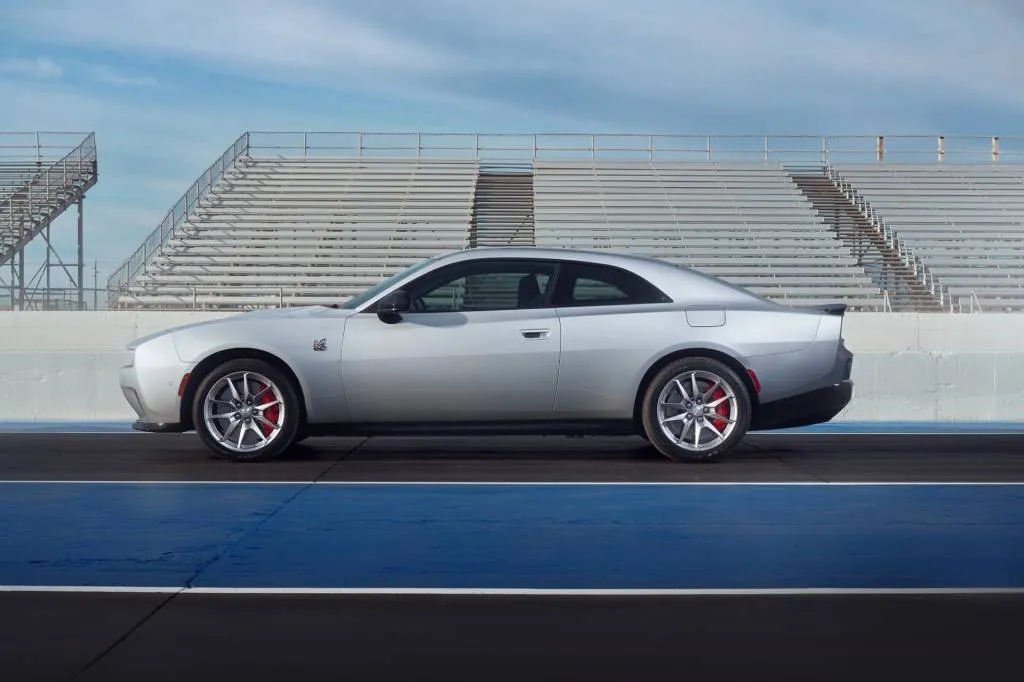
2024 Dodge Charger Daytona
“That was the production car hiding in plain sight,” Dodge CEO Tim Kuniskis told media assembled at a preview last week. “We had to tell that brotherhood what we were doing—they needed that soak time—how we were going to approach electrified performance before anyone else.”
The result, on paper and in person, is as impressive as the concept.
The key characteristic carrying over from the concept is what Dodge calls the R-Wing bridging the nose. It’s an “air neutral” feature over a nose that dips down so low as to lower the coefficient of drag. The wing creates a boxy frame underscored by thin daytime running light across the length of the face before curling up toward the wing. Without it, the nose would mimic the prodigious proboscis of its inspiration, the 1968 Dodge Charger Daytona with the enormous nose cone and the 23-inch tall rear wing.
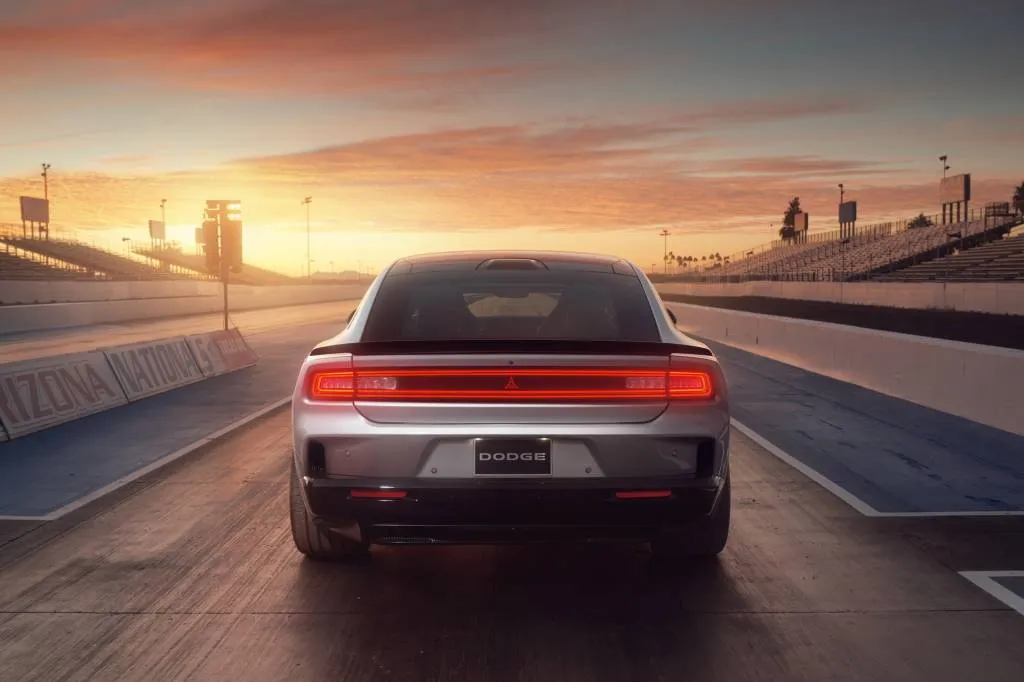
2024 Dodge Charger Daytona
The visual width of the front and rear, with its signature racetrack rectangular lighting, is not an illusion. At 79.8 inches (without mirrors), it’s nearly five inches wider than the 2023 Dodge Charger. “It’s one of the widest vehicles on the road short of duallie trucks to cover those massive tires,” head of Dodge design Scott Krugger said. The standard wheels on the base R/T are 18 inches in diameter, but the staggered tires on the Track Package exclusive to the Scat Pack consist of Goodyear Eagle F1 Supercar 3 305/35ZR20s up front on 11-inch wide wheels and 325s on 11.5-inch wide wheels in back.
That package also includes the largest brake setup ever offered on a factory Dodge with 6-piston Brembo calipers up front and 4-piston calipers in back clamping down on 16.0-inch rotors front and rear. It seems necessary for a car weighing 5,838 pounds and rocketing to 60 mph in 3.3 seconds.
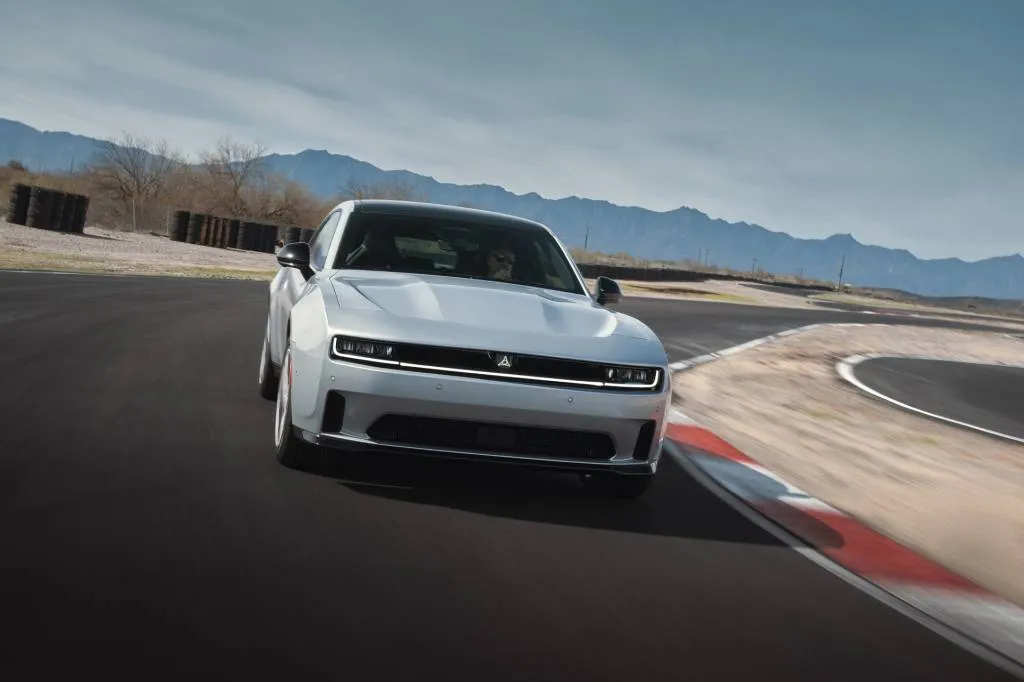
2024 Dodge Charger Daytona
2024 Dodge Daytona power and specs
“We are gonna displace superchargers and replace them with kilowatts and Power Shots,” Kuniskis said. “The ultimate performer is going to be the Banshee (late in 2025) but we are gonna have the bridge of ICE in there in the meantime.”
That’s right, a Charger powered by an internal-combustion engine will return, but it won’t be a V-8. A twin-turbo 3.0-liter inline-6 with a choice of 420 hp or 550 hp will arrive in the first quarter of 2025 as the Charger Sixpack adopting the Hurricane engine used in Jeep and Ram products.
The battery electric versions—badged Charger Daytona—arrive first, this summer, and are expected to lead the charge in sales.
Daytona models use a 100.5-kwh (93.5-kwh usable) lithium-ion battery pack serving two drive units with 250-kw motors, one for each axle for standard all-wheel drive.
For the launch year, Dodge includes its Power Shot upgrade that provides an extra 40 hp of burst for 15-second intervals. It’s a hot button on the steering wheel to use when you don’t want to fiddle with the drive mode button on the opposite side of the wheel. It requires 30-second breathers between bursts.
Next year, the Power Shot will cost extra, and to be clear, Dodge brands it the Direct Connection Stage 1 (R/T) or Stage 2 (Scat Pack) upgrade kit. That brings the total output of the Charger Daytona R/T kit to 496 hp and 404 lb-ft of torque. Dodge estimates a 0-60 mph time of 4.7 seconds, a quarter-mile of 13.1 seconds, and a top speed of 137 mph.
The Daytona Scat Pack boosts output to 670 hp and 627 lb-ft. It specs out to a 0-60 mph time of 3.3 seconds, a quarter-mile of 11.5 seconds, and a top speed of 134 mph.
The predecessor’s R/T and Scat Pack models had a 0-60 mph time of 4.3 seconds.
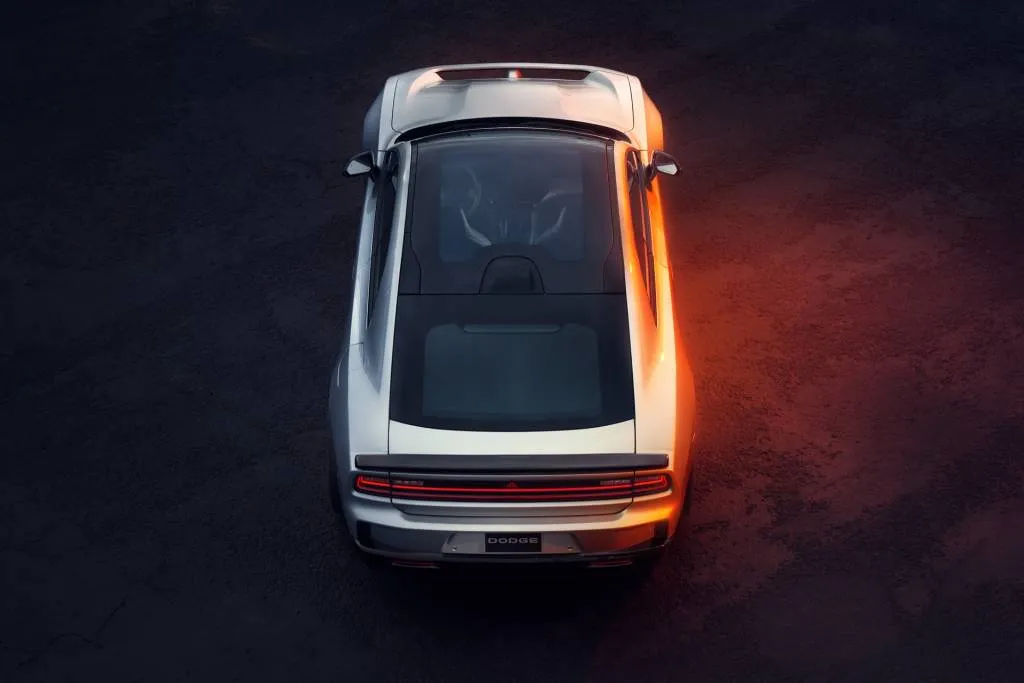
2024 Dodge Charger Daytona
What about range and efficiency?
“I don’t care,” Kuniskis said. “It’s not designed to get you 500 miles of range. This is designed to be the ultimate performance car until we come out with the Banshee, of course.”
Yet, the Charger Daytona is no slouch when it comes to range. The R/T is EPA-estimated at 317 miles of range with 20-inch wheels. The Scat Pack rates at 260 miles, as long as you lay off the Power Shot.
Only the Daytona Banshee expected in late 2025 will have the 2-speed transmission Dodge teased with the concept.
The Charger Daytona R/T and Scat Pack have three levels of regenerative braking via paddle shifters, but no one-pedal drive mode. There is a launch control function, of course.
The front drive unit has a disconnect to cut power to the wheels and improve range and efficiency, while the rear unit has a mechanical limited-slip differential for better traction out of corners. Drive modes include the usual suspects, while Scat Packs get Drag, Drift, and Donut modes that cut or limit power to the front axle and neuter the traction control system. The Scat Pack Track Pack adds adaptive dampers to the multilink front and rear suspensions, and in Drift mode the front dampers go soft and the rear dampers ratchet up to the stiffest setting to induce oversteer.
It also has an exhaust system, sort of. The chambered Fratzonic exhaust uses speakers under the body that are amplified by resonators, like a muffler resonator, then piped out of the exhaust. It’s augmented by electronics inside, and makes what Dodge calls “Hellcat levels of sound.” It could vibrate the car like a V-8, or be silenced in stealth mode.
For the first round of Charger Daytonas, the 400-volt architecture supports a peak DC fast-charge rate of 183 kw, enabling a 20-80% state of charge in about 28 minutes. At home on a Level 2 240-volt connection, the Daytona’s 11-kw onboard charger replenishes the battery from 5-80% in about seven hours. In 2025, Dodge owners will have access to Tesla’s Supercharger network.
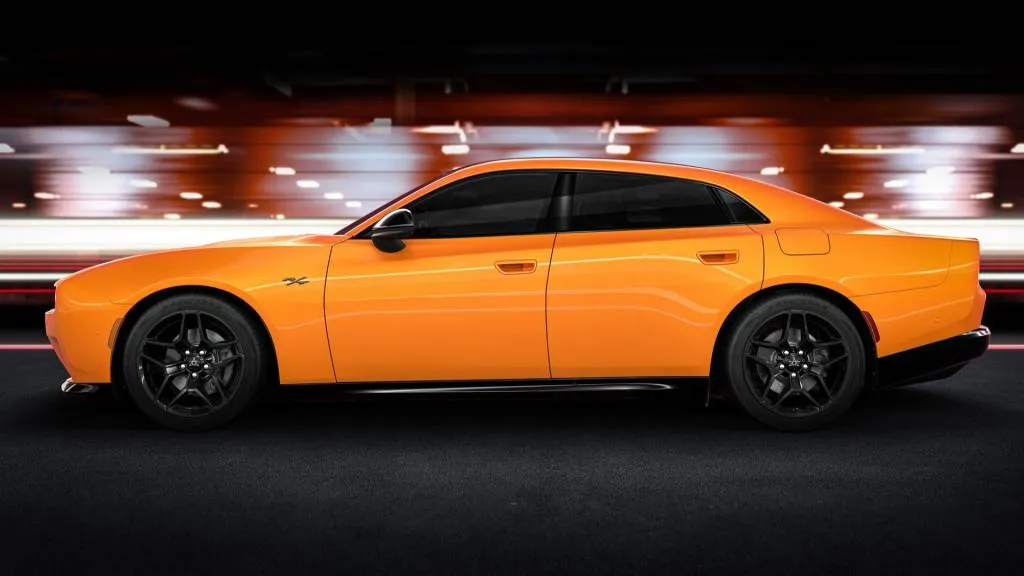
2024 Dodge Charger Daytona
How big is the 2024 Dodge Charger Daytona?
Employing Stellantis’ STLA Large multi-energy platform, the Dodge Charger Daytona occupies a larger footprint than the old Charger, and beginning in 2025, the three-door hatchback will be complemented by a five-door option that looked especially striking on display in Peel Out orange, though the prototype lacked rear seats.
The 2024 Charger Daytona extends half a foot longer than the outgoing gas Charger to 206.6 inches, and it has a 121-inch wheelbase (1.0 inch longer than its predecessor). It doesn’t translate to that much more room for passengers, though cargo room increases considerably due to the hatch instead of a trunk, 133% more, according to Dodge. There’s a shallow but long 23.0 cubic feet of space in the hatch, which has a hidden floor, and buyers will be able to fold down the 60:40-split rear seats to open up a crossover-like 38.5 cubic feet of space, roomy enough to fit a set of four track tires, Dodge suggested.
The rear seats might be best folded down, at least for taller people. Up front, headroom is ample, even with the available fixed-glass roof, but in back, it could crimp the flow of 6-footers. Rear legroom of 37.2 inches matches most compact crossovers, so it’s reasonable to fit four passengers in the three-door model. Since the five-door model just moves the B-pillars up, we expect it will be snug in back for larger people.
The Charger Daytona is an inch taller than its predecessor at 59.0 inches, and the ground clearance increases from 5.2 to 5.6 inches, but that’s to house the large battery pack in the floor.
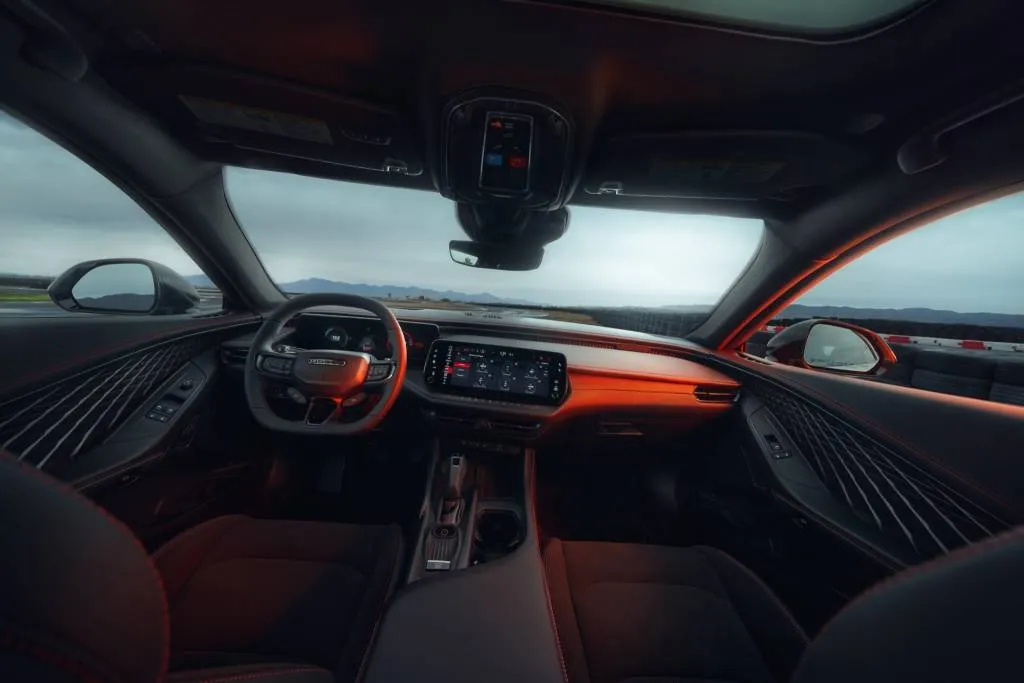
2024 Dodge Charger Daytona
How much is the 2024 Dodge Charger Daytona?
We won’t know until nearer its summer release date, but we expect the Daytona R/T to cost about $55,000 and the Scat Pack to come in around $70,000. Battery production is expected to move from Korea to Kokomo, Ind., in 2025, so the electric muscle car made in Windsor, Ontario, Canada, then should qualify for the federal EV tax credit.
